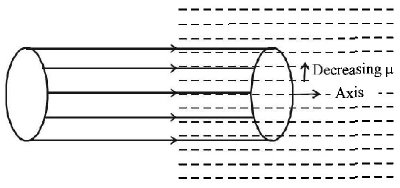1. White light used to illuminate the two slits in Young’s double slit experiment. The separation between the slits is d and the distance between the screen and the slit is $$D\left( { > > d} \right).$$ At a point on the screen in front of one of the slits, certain wavelengths are missing. The missing wavelengths are
A.
$$\lambda = \frac{{{d^2}}}{{\left( {2n + 1} \right)D}}$$
B.
$$\lambda = \frac{{\left( {2n + 1} \right){d^2}}}{D}$$
C.
$$\lambda = \frac{{{d^2}}}{{\left( {n + 1} \right)D}}$$
D.
$$\lambda = \frac{{\left( {n + 1} \right)D}}{{{d^2}}}$$
Answer :
$$\lambda = \frac{{{d^2}}}{{\left( {2n + 1} \right)D}}$$
2. Monochromatic light of wavelength $$400\,nm$$ and $$560\,nm$$ are incident simultaneously and normally on double slits apparatus whose slits separation is $$0.1\,mm$$ and screen distance is $$1\,m.$$ Distance between areas of total darkness will be
A.
$$4\,mm$$
B.
$$5.6\,mm$$
C.
$$14\,mm$$
D.
$$28\,mm$$
Answer :
$$28\,mm$$
3. In a Young's double slit experiment, slits are separated by $$0.5\,mm,$$ and the screen is placed $$150\,cm$$ away. A beam of light consisting of two wavelengths, $$650\,nm$$ and $$520\,nm,$$ is used to obtain interference fringes on the screen. The least distance from the common central maximum to the point where the bright fringes due to both the wavelengths coincide is :
A.
$$9.75\,mm$$
B.
$$15.6\,mm$$
C.
$$1.56\,mm$$
D.
$$7.8\,mm$$
Answer :
$$7.8\,mm$$
4.
In an experiment, electrons are made to pass through a narrow slit of width $$‘d’$$ comparable to their de Broglie wavelength. They are detected on a screen at a distance $$‘D’$$ from the slit (see figure).
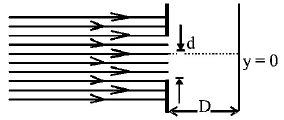
Which of the following graphs can be expected to represent the number of electrons $$‘N'$$ detected as a function of the detector position $$‘y’$$ ($$y = 0$$ corresponds to the middle of the slit)
A.
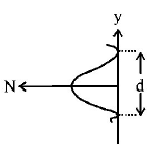

B.
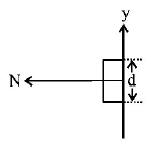

C.
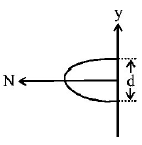

D.
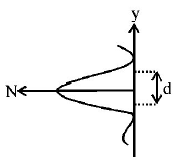

Answer :


5. In a double slit experiment instead of taking slits of equal widths, one slit is made twice as wide as the other. Then, in the interference pattern
A.
the intensities of both the maxima and the minima
increase
B.
the intensity of the maxima increases and the minima
has zero intensity
C.
the intensity of the maxima decreases and that of the
minima increases
D.
the intensity of the maxima decreases and the minima
has zero intensity
Answer :
the intensities of both the maxima and the minima
increase
6.
Consider the $$YDSE$$ arrangement shown in figure. If $$d = 10\lambda $$ then position of 8th maxima is
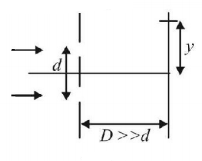
A.
$$y = \frac{D}{{10}}$$
B.
$$y = \frac{D}{{3}}$$
C.
$$y = \frac{4}{5}D$$
D.
$$y = \frac{{4D}}{3}$$
Answer :
$$y = \frac{{4D}}{3}$$
7. Young’s double slit experiment is made in a liquid. The 10th bright fringe lies in liquid where 6th dark fringe lies in vacuum. The refractive index of the liquid is approximately
A.
1.8
B.
1.5
C.
1.3
D.
1.6
Answer :
1.8
8. Two monochromatic light beams of intensity $$16$$ and $$9$$ units are interfering. The ratio of intensities of bright and dark parts of the resultant pattern is :
A.
$$\frac{{16}}{9}$$
B.
$$\frac{4}{3}$$
C.
$$\frac{7}{1}$$
D.
$$\frac{49}{1}$$
Answer :
$$\frac{49}{1}$$
9.
An initially parallel cylindrical beam travels in a medium of refractive index $$\mu \left( I \right) = {\mu _0} + {\mu _2}I,$$ where $${\mu _0}$$ and $${\mu _2}$$ are positive constants and $$I$$ is the intensity of the light beam. The intensity of the beam is decreasing with increasing radius.
As the beam enters the medium , it will
A.
diverge
B.
converge
C.
diverge near the axis and converge near the periphery
D.
travel as a cylindrical beam
Answer :
converge
10. Two beams, $$A$$ and $$B,$$ of plane polarized light with mutually perpendicular planes of polarization are seen through a polaroid. From the position when the beam $$A$$ has maximum intensity (and beam $$B$$ has zero intensity), a rotation of polaroid through 30° makes the two beams appear equally bright. If the initial intensities of the two beams are $${I_A}$$ and $${I_B}$$ respectively, then $$\frac{{{I_A}}}{{{I_B}}}$$ equals :
A.
3
B.
$$\frac{3}{2}$$
C.
1
D.
$$\frac{1}{3}$$
Answer :
$$\frac{1}{3}$$
